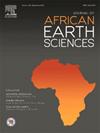Ground fissures in the central Ethiopian Rift: insights on distribution, genesis and hazard
IF 2.2
4区 地球科学
Q2 GEOSCIENCES, MULTIDISCIPLINARY
引用次数: 0
Abstract
Ground fissuring is an endemic hazard along the East African Rift, rather common in the volcanic lacustrine deposits of Ethiopia and Kenya. Fissures reach lengths of kilometers and widths of several meters, menacing villages and infrastructures, locally taking the shape of coalescing holes. In this study, the phenomenon has been mapped over the Central Main Ethiopian Rift (CMER), based on field observation and remotely sensed images. Geophysical investigations (geoelectrical and seismic profiles) at two sites (Ziway and Muleti), have provided informative imaging of the underground across recent ruptures. No premonitory ground deformation has ever been reported before the opening of the fissures, whose strike corresponds to that of the widespread system of Late Quaternary faulting inside the Rift. However, while a structural control seems well established, a genetic correspondence of the two phenomena, as observed to the north in the NMER or locally in the western flank of the rift, cannot be proven. As well, no direct link with seismicity does exist. Heavy rains appear to trigger such linear collapses, as in 2016, but again a biunivocal relationship is not yet verified. Thus, this local source of serious hazard remains elusive and unpredictable, unless widespread, and expensive, geophysical and borehole investigations are carried out, possibly supported by high resolution remotely-sensed DinSAR monitoring, still to be proven effective though.
埃塞俄比亚中部裂谷的地裂缝:对分布、成因和危害的见解
地面裂缝是东非大裂谷沿线的一种地方性灾害,在埃塞俄比亚和肯尼亚的火山湖相沉积物中相当常见。裂缝长达几公里,宽达几米,威胁着村庄和基础设施,局部呈聚结洞的形状。在这项研究中,根据实地观测和遥感图像,在埃塞俄比亚中部主要裂谷(CMER)上绘制了这一现象。在两个地点(Ziway和Muleti)进行的地球物理调查(地电和地震剖面)提供了最近断裂的地下信息成像。在裂缝打开之前,没有任何前兆的地面变形的报道,其走向与裂谷内广泛的晚第四纪断裂系统相对应。然而,虽然构造控制似乎已经确立,但在NMER北部或裂谷西侧局部观察到的这两种现象的遗传对应性无法得到证实。同样,也不存在与地震活动的直接联系。暴雨似乎引发了这种线性崩塌,就像2016年一样,但这种双向关系仍未得到证实。因此,除非进行广泛和昂贵的地球物理和钻孔调查,并可能得到高分辨率遥感DinSAR监测的支持,否则这种当地的严重危险源仍然难以捉摸和不可预测,但仍有待证明其有效性。
本文章由计算机程序翻译,如有差异,请以英文原文为准。
求助全文
约1分钟内获得全文
求助全文
来源期刊

Journal of African Earth Sciences
地学-地球科学综合
CiteScore
4.70
自引率
4.30%
发文量
240
审稿时长
12 months
期刊介绍:
The Journal of African Earth Sciences sees itself as the prime geological journal for all aspects of the Earth Sciences about the African plate. Papers dealing with peripheral areas are welcome if they demonstrate a tight link with Africa.
The Journal publishes high quality, peer-reviewed scientific papers. It is devoted primarily to research papers but short communications relating to new developments of broad interest, reviews and book reviews will also be considered. Papers must have international appeal and should present work of more regional than local significance and dealing with well identified and justified scientific questions. Specialised technical papers, analytical or exploration reports must be avoided. Papers on applied geology should preferably be linked to such core disciplines and must be addressed to a more general geoscientific audience.
 求助内容:
求助内容: 应助结果提醒方式:
应助结果提醒方式:


